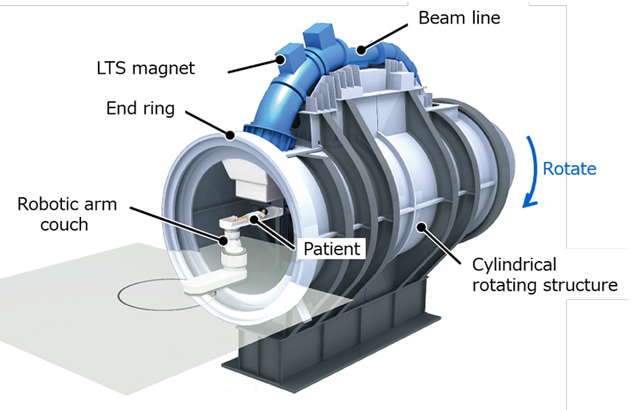AP7-2-INV
Design and Test Results of Superconducting Rotating Gantry for East Japan Heavy Ion Center
*Shigeki Takayama1, Takashi Yazawa1, Masaki Asano1, Masato Misawa1, Yoshifumi Nagamoto1, Saki Amano1, Tomofumi Orikasa1, Yutaka Hirata1, Lee SH2, Takayuki Kanai2, Hikaru Souda2, Takeo Iwai2
- Toshiba Energy Systems & Solutions Corporation1
- Yamagata University2
Rotating gantry is a cylindrical irradiation equipment with magnets for beam transport and beam scanning (Fig.1). It can deliver particle beams precisely to a tumor from any direction without changing the posture of the patient, so that it makes possible to concentrate the physical dose to the tumor and also reduce the dose on normal cells. Therefore, it's commonly used in proton radiotherapy in recent year. On the other hands, in the carbon-ion radiotherapy, the size of the rotating gantry was too huge to install in general hospitals because of the high magnetic rigidity of therapeutic carbon-ions. To reduce the size of this gantry, the first superconducting gantry had been developed and installed in collaboration with the National Institutes for Quantum and Radiological Science and Technology (QST). It is an iso-centric gantry with an axial length of 13 m and a radius of 5.5 m. This gantry was composed of ten low-temperature superconducting (LTS) magnets, and the maximum dipole and quadrupole field were 2.88T and 9.3 T/m, respectively. The commissioning of this rotating gantry has been already completed, and therapeutic irradiation is currently underway. Based on the results of this development, a next generation compact superconducting rotating gantry had been developed in the project of East Japan Heavy Ion Center, Faculty of Medicine, Yamagata University. To achieve further downsizing of the rotating gantry, the length of scanning irradiation system is shortened and the magnetic field of the superconducting magnet is increased up to 3 T over. As a result, the gantry is downsized to 2/3 of the first superconducting rotating gantry. This gantry has already been installed and is working for preclinical commissioning at Yamagata University. The same type of rotating gantry is planned to be installed into the Yonsei University Health System and Seoul National University Hospital, too. This presentation will be reported on this gantry and its superconducting magnet.
